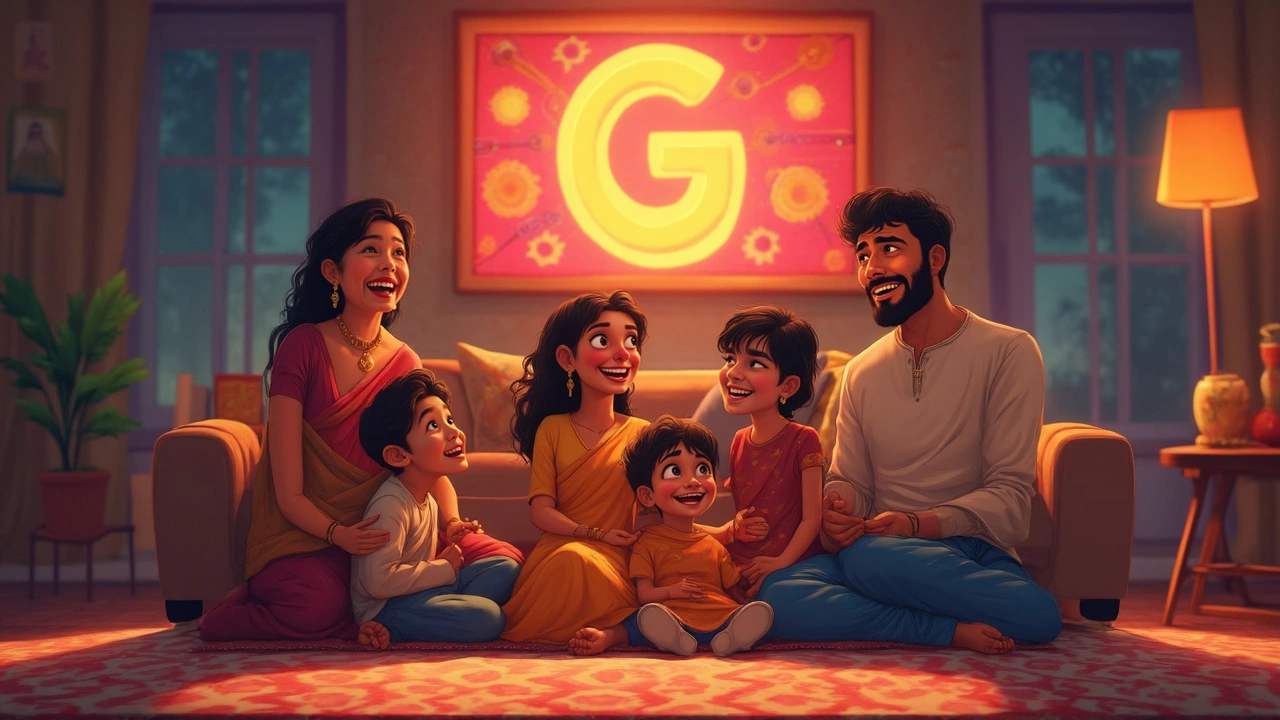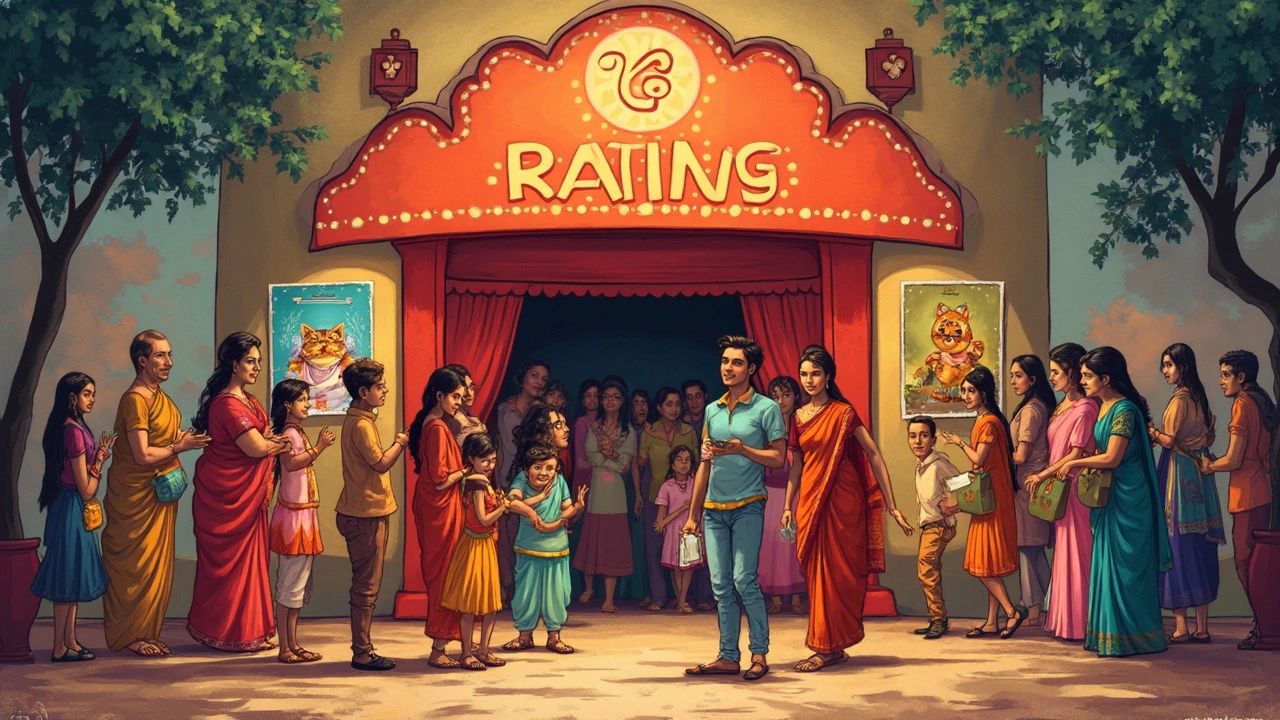What Does G Mean in Movies? Breaking Down Movie Ratings
 Apr, 23 2025
Apr, 23 2025
Notice those big bold letters on a movie poster, like 'G'? Ever paused and asked what that really means, especially in India? G isn’t just a random letter tossed around by film boards. It’s code, and it’s supposed to make movie choices easier—especially for parents or anyone trying to avoid awkward scenes with family or friends.
So here's the deal: a G-rated film is pretty much the safest pick out there. No intense violence, no spicy language, no love scenes that’ll have you reaching for the remote. It stands for 'General Audience,' which means anyone can watch it, even your little cousin who thinks Minions are real. The G label is more than a guideline. It sets the tone for what you can expect, and, sometimes, what you shouldn’t.
- What Does G Rating Mean?
- How Movies Get a G Rating in India
- Famous G-Rated Movies
- Tips for Picking the Right Family Movie
What Does G Rating Mean?
That G rating you keep seeing? It stands for “General Audience.” Sounds simple, but it does a lot of heavy lifting in the movie world. In plain words, it means the film is suitable for all ages—kids, teens, grandparents, and everyone in between. This label is the safest bet when you’re not in the mood for surprises on screen.
The G rating sets clear limits. If you see this label, you don’t have to worry about strong language, blood, nasty jokes, or any kind of adult situations. Even scary scenes usually get dialed way down, so younger viewers aren’t likely to get nightmares. These rules are crystal clear, especially for studios that want their movie to be a family hit.
Here’s a simple breakdown of what makes a movie fit the G rating:
- No swearing or harsh language
- No sexual content or steamy scenes
- No strong violence or disturbing situations
- No heavy themes that could upset young viewers
In the U.S., the G rating comes from the MPAA (now MPA), while in India, the Central Board of Film Certification (CBFC) uses the "U" certificate, which closely matches the G rating system. Both systems have the same goal: make sure anyone can watch without stress.
Here’s a quick look at how the G rating compares globally:
| Country | Rating Label | Meaning |
|---|---|---|
| USA | G | General Audience |
| India | U | Universal (suitable for all) |
| UK | U | Universal (everyone) |
The next time you’re picking a movie and “G” pops up, you know you won’t have awkward moments or fast-forwarding runs while watching with the whole family.
How Movies Get a G Rating in India
Curious about how a film earns that neat G rating in India? The process is handled by the Central Board of Film Certification (CBFC). You might’ve heard folks call it the censor board. This board is the gatekeeper for every movie hitting theatres or streaming platforms. Before a film can be released, it has to be cleared by them.
For a movie to snag a G rating (sometimes called 'U certificate' in India), it needs to play by some pretty clear rules. No super graphic violence, no cussing, and definitely no scenes that could make parents squirm while watching with their kids. The CBFC looks out for things like:
- Violence. Cartoon chaos is usually fine—think Tom and Jerry smashing each other with frying pans—but nothing bloody or disturbing.
- Language. No swear words or rude jokes. Dialogues need to stay friendly for everyone.
- Romance. Hand-holding or maybe a simple hug is okay. Anything more? It’s out.
- No horror or supernatural threats that could seriously scare kids.
- No drug use, alcohol abuse, or smoking shown in a cool or positive light.
If the movie ticks all the right boxes, the filmmakers get a green light for a G rating. But it’s not just a stamp; the board actually watches each film—sometimes multiple times—to be sure. If something small stands out, they’ll ask for edits before giving the final nod.
Here's a quick look at what the CBFC is checking for during the process:
| Criteria | Allowed in G-rated (U Certificate)? |
|---|---|
| Violence | Mild, cartoonish only |
| Language | Polite and child-friendly |
| Romantic Content | Very basic, nothing suggestive |
| Horror Elements | Minimal, not frightening |
| Substance Use | None shown as positive or aspirational |
So next time you see that G—or 'U'—on an Indian movie, you know a panel has gone over every frame to keep it as kid- and family-friendly as possible. No nasty surprises, just safe, all-ages fun.

Famous G-Rated Movies
When you think of a G rating, cartoons probably come to mind first, but it goes way beyond just animated flicks. Some of the most iconic films on the planet have worn the G proudly—and not just in Hollywood. In India, and across the globe, a G-rated movie basically means you can watch without worrying you'll need to cover your eyes or ears at any moment.
Take Disney classics like The Lion King (1994) or Finding Nemo (2003)—both are G-rated and still get played at family get-togethers. Even decades-old movies like Mary Poppins (1964) and The Sound of Music (1965) carry the G rating banner. For many parents, these aren’t just safe; they’re nostalgic.
Switching gears to India, family-friendly animation or mythological stories often bag the G rating. Think of titles like Chhota Bheem and the Curse of Damyaan and Hanuman. These are built for all ages and loaded with positive messages, which is why they're favorites during school vacations and festival holidays.
Ever wondered which production studios crank out the most G-rated content? Check out this slice of data:
| Studio | Top G-Rated Films | Release Years (Range) |
|---|---|---|
| Disney/Pixar | The Lion King, Finding Nemo, Toy Story | 1994 – 2010 |
| Warner Bros. | The Iron Giant, Happy Feet | 1999 – 2006 |
| Indian Animation Studios | Chhota Bheem, Hanuman | 2005 – 2013 |
Remember, a G-rated film isn’t always “kiddie” stuff. Some, like the ones above, deal with meaningful topics—loss, perseverance, teamwork—but without anything graphic or over-the-top. That’s why these movies keep topping “safe for all ages” lists year after year.
Tips for Picking the Right Family Movie
Choosing a movie everyone can enjoy without worrying about awkward or scary scenes is a big win. G-rated or family films sound like the obvious pick, but even in the Indian cinema scene, not all movies with a safe label deliver the same vibe. Some G-rated titles feel like a snooze fest, while others actually get the whole family laughing or thinking. So how do you spot the gems?
- Check the official rating first. In India, the CBFC (Central Board of Film Certification) puts a big laurel 'U' on movies, meaning universal—or G rating in everyday talk. This doesn't mean every detail is for tiny kids, but it does mean no bad language, nudity, or brutal fights.
- Read quick reviews. Sometimes the rating doesn’t catch everything. Look for short parent-focused summaries that highlight if the film has any scary themes, grown-up jokes, or draggy moments. Sites like Common Sense Media, IMDb, or Indian movie forums can help.
- Think about the group’s taste. Animation, musicals, or simple comedy usually work, but not every kid (or adult) digs the same thing. For example, kids under 7 might zone out if the movie is too wordy, while tweens may find cartoons boring unless they’re like "The Lion King" or "Finding Nemo."
- Consider the run time. Most families with younger kids do better with shorter movies—under 2 hours is usually a sweet spot, especially after dinner.
- Don’t underestimate old classics. Indian classics like "Chhota Chetan" or "Taare Zameen Par" get a 'U' rating and hold up across generations. Hollywood’s long list of G rated winners, from "Toy Story" to "Mary Poppins," never really get old.
If you love data, check this out. G-rated movies usually do better with families at the box office, proving they're still in demand. Take a look:
| Movie | Box Office Gross (INR Crore) | India Release Year |
|---|---|---|
| The Lion King (2019) | 158 | 2019 |
| Taare Zameen Par | 62 | 2007 |
| Finding Nemo | 25 | 2003 |
If you’re stuck, just stick to well-reviewed G-rated picks. Your odds of a disaster movie night go way down. And if you want to add local flavor, check new releases with a 'U' certificate—plenty of Indian studios regularly make solid family films that are basically tailor-made for home viewing together.